A New Iterative Numerical Continuation Technique for Approximating the Solutions of Scalar Nonlinear Equations
Abstract
The present study concerns the development of a new iterative method applied to a numerical continuation procedure for parameterized scalar nonlinear equations. Combining both a modified Newton’s technique and a stationary-type numerical procedure, the proposed method is able to provide suitable approximate solutions associated with scalar nonlinear equations. A numerical analysis of predictive capabilities of this new iterative algorithm is addressed, assessed, and discussed on some specific examples.
1. Introduction
The resolution of scalar nonlinear equations is an issue frequently encountered in many branches of physical sciences such as mechanics [1–5]. Although, in the literature, the most used numerical methods are either the classical Newton’s technique [3, 4, 6] or modified Newton-type procedures [7–10], they suffer from the main disadvantage of being held in check in the presence of critical points [11]. In order to overcome this deficiency, we propose to develop a new iterative algorithm applied to a numerical continuation procedure [5] for providing the approximate solutions associated with parameterized scalar nonlinear equations. The presented algorithm is based on a modified Newton-type method coupled with a stationary numerical technique. This study is organized in the following manner: (i) in Section 2, the standard numerical continuation procedure is briefly recalled including some classical algorithms; (ii) in Section 3, the new proposed iterative numerical method is presented in detail; (iii) in Section 4, the predictive abilities associated with this new iterative algorithm are tested and evaluated on some examples.
2. Standard Numerical Continuation Methods
2.1. Problem Statement
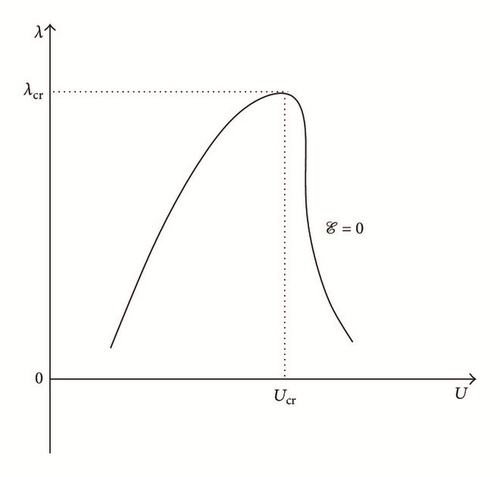
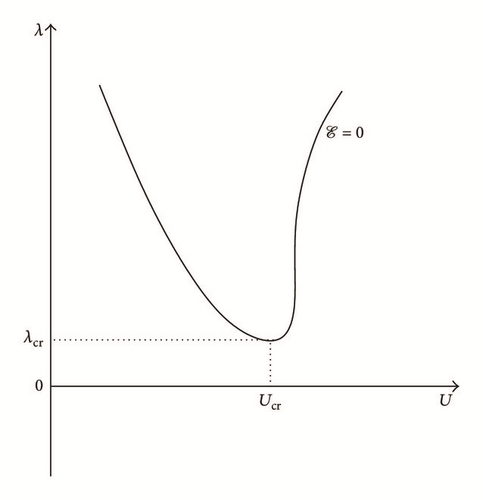


2.2. Some Commonly Used Algorithms
2.2.1. Classical Newton and Newton-Type Procedures
By placing in the context of solid mechanics and considering that the physical time t = [0, T] (with ) is divided into (N + 1)-subintervals [tn, tn+1] (i.e., T = (N + 1)Δt with Δt = Δtn+1 = tn+1 − tn and tn+1 = (n + 1)Δt, ∀n = 0, …, N with ), we have the displacement U(t) and the mechanical load λ(t) at the incremental time tn (resp., tn+1) that are written as follows: U(tn) ≡ Un and λ(tn) ≡ λn (resp., U(tn+1) ≡ Un+1 and λ(tn+1) ≡ λn+1).
- (i)
classical Newton’s algorithm (see case (a) of Figure 2; cf. [3, 4, 7]):
() - (ii)
Newton-type algorithm (see case (b) of Figure 2; cf. [3, 4, 7]):
() -
where denotes a coefficient which checks with , sgn(·) is the sign function (such as sgn(φ) = −1 when φ < 0, sgn(φ) = 1 when φ > 0, and sgn(φ) = 0 when φ = 0), and |φ| is the absolute-value function (such as |φ | = −φ when φ < 0 and |φ | = φ when φ ≥ 0). It is worth noting that if then this is the classical Newton’s algorithm and if κ = C (with C being the constant coefficient which does not depend on the point and checking and ) then this is the modified Newton’s algorithm.
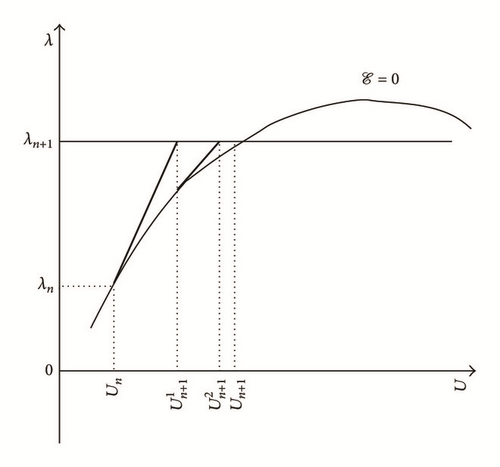
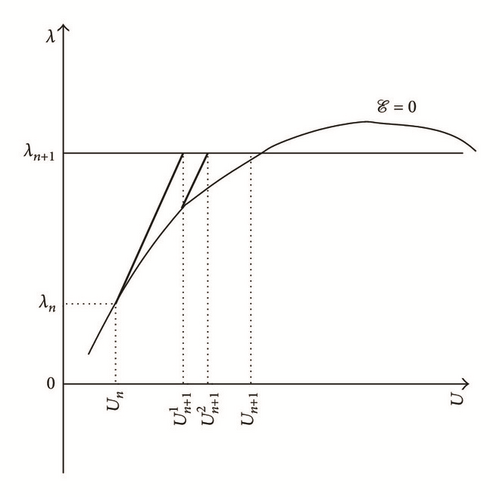
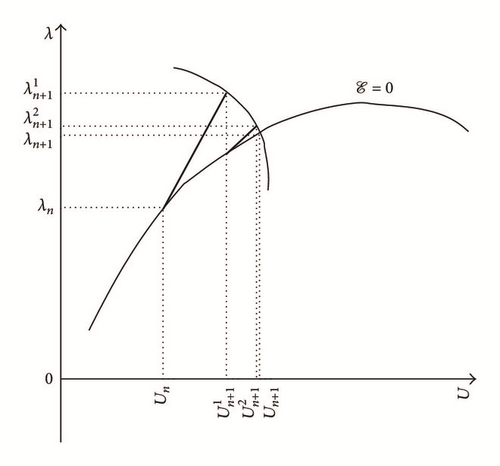

2.2.2. Standard Arclength and Pseudo-Arclength Procedures
- (i)
the equation is nonlinear type (second order) in the case of an arclength algorithm (see case (c) of Figure 2) (e.g., Crisfield procedure [5, 12, 13]);
- (ii)
the equation is linear type in the case of a pseudo-arclength algorithm (see case (d) of Figure 2) (e.g., Riks [14–17], Ramm [18, 19], or Wempner [20] procedures).
It may be stressed that there exist many other methods used for numerical continuation procedures; one of them, which is not present here, is called “normal flow algorithm” or “Davidenko’s flow algorithm” (see [21, 22] for more details); the mechanical equilibrium equation of solid associated with the Davidenko’s flow reads , where χ denotes the perturbation parameter.
3. A New Iterative Numerical Continuation Method
3.1. Proposed Algorithm
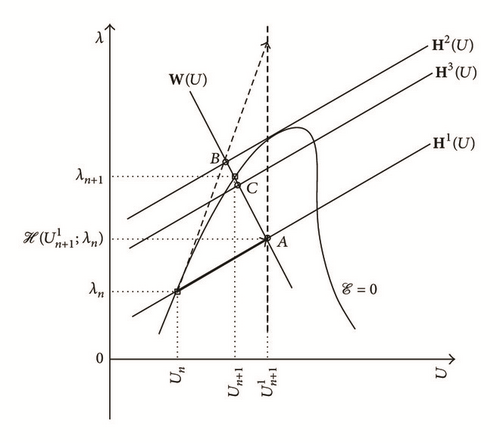
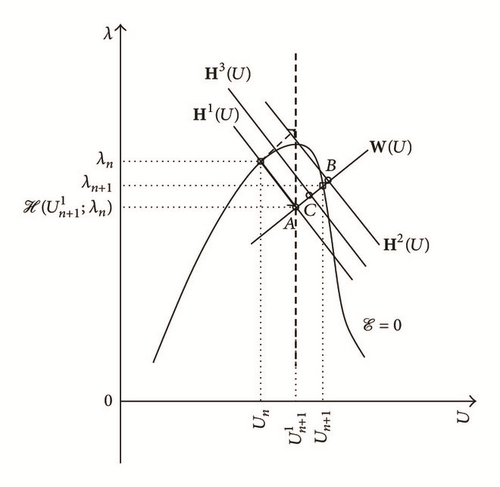
3.2. Some Comments
- (1)
For the first iterative step at the first increment (i.e., k = 1 and n = 0), the choice of sign “±” in (17) is arbitrary and depends only on the direction for beginning the numerical continuation procedure. Further in this study, we adopt the sign “+.” Nevertheless, for the other first iterative steps at other increments (i.e., k = 1 and n ≥ 1), we consider a certain continuity of path with respect to the previous converged increment and we adopt the following rule: (i) the sign “+” when or and ; (ii) the sign “−” when or and .
- (2)
The new proposed iterative algorithm (see Section 3.1) uses the first-order partial derivative operator as classical Newton’s algorithm (see Section 2.2.1), but unlike this latter, the critical points can be passed without relatively strong difficulties. Based on a modified Newton’s procedure, the new algorithm considers iterative steps of predictions and corrections which depend on both the first-order partial derivative operator , ∀k = 0, …, K, ∀n = 0, …, N) and its inverse , ∀k = 0, …, K, ∀n = 0, …, N) modulated by two parameters (α and β) allowing to pass through the limit points for the first (see (17) and (18)) and other iterations (see (23) and (24)) during a discrete-time interval.
- (3)
The two values associated with the function Θ (see (15) and (24)), which is a linear combination of the first-order partial derivative operator and its inverse , ∀k = 0, …, K, ∀n = 0, …, N), represent the fact that are considered: (i) when Θ = Θ1, the initial straight line previously converged (i.e., with k = 0, ∀n = 0, …, N); (ii) when Θ = Θ2, the current iterative straight line is (∀k = 0, …, K, ∀n = 0, …, N).
- (4)
The new proposed algorithm is composed of three parameters: α, β, and γ. The optimal values of these parameters depend clearly on the nonlinear function under consideration. Therefore, a sensibility analysis must be conducted in order to obtain these optimal values. An alternative approach consists, in the first time, to choose the following values: (i) for α given: (i-a) β = α and γ = 1; (i-b) β = 1/α and γ = 1; and (i-c) β = 0 and γ = 1; (ii) for β given: (ii-a) α = 0 and γ = 1. On the other hand, in the case where α = 1 and β = 0, the new proposed algorithm reduces to a pseudo-arclength type procedure (see Section 2.2.2).
4. Some Numerical Examples
4.1. Preliminary Remarks
In the current section, we propose to test and evaluate the accuracy, efficiency, and robustness associated with the developed iterative method associated with the numerical continuation procedure in Section 3 on some scalar nonlinear equations. Moreover, all the numerical results of this section have been obtained with MATLAB software (see [7]).
- (i)
For the iterative solution (k ≥ 1), one has the following:
- (a)
For the first iteration (k = 1),
() -
with
() - (b)
For the other iterations (k ≥ 2),
()
- (a)
-
with
() - (ii)
For the iterative solution (k ≥ 1),
()
- (i)
On the one hand, we consider only the case where Θ = Θ1 for the new continuation algorithm (see (26)–(30)) used in this section.
- (ii)
On the other hand, we introduce four types of Convergence Criterion (CCl) (with l = 1, …, 4) in order to stop the iterative process associated with the new proposed algorithm:
() -
where Kmax represents the maximum number of iterations, ϵre and ϵae1 (resp., ϵae2) are the tolerance parameters associated with the residue error of the function and approximation error criterion of displacement U (resp., mechanical load λ). In what follows, we consider the following values for each CC: Kmax = 30, ϵre = 10−10, and ϵae1 = ϵae2 = 10−10.
4.2. Examples
4.3. Results and Discussion
4.3.1. Predictive Numerical Capabilities
All the numerical results associated with scalar nonlinear functions (E1) to (E3) (see Section 4.2) are presented in Figures 4–6. The obtained numerical results show fairly clearly that the new proposed iterative numerical algorithm (see Section 3) is capable of giving convenient approximate solutions associated with parameterized scalar nonlinear equations including critical points. Indeed, in Example 1 (E1), there are four critical points and we can see that the new iterative algorithm is able to pass all these points: (i) the first (Ucr, λcr) = (100,0) (representing case (c) of Figure 1); (ii) the second (Ucr, λcr) = (0, −100) (representing case (b) of Figure 1); (iii) the third (Ucr, λcr) = (−100,0) (representing case (d) of Figure 1); and (iv) the fourth (Ucr, λcr) = (0,100) (representing case (a) of Figure 1). In Example 2 (E2), there is only one critical point (Ucr, λcr) = (10,50) (representing case (a) of Figure 1) and the new iterative algorithm passes without excessive difficulty this singularity. In the same way, in Example 3 (E3), there are periodic critical points and we can see that the new algorithm passes again the first (Ucr, λcr) = (157,100) (representing case (a) of Figure 1) and the second (Ucr, λcr) = (471, −100) (representing case (b) of Figure 1) singularity associated with the nonlinear function in the interval [0, Tper] (where Tper = 2π/η ≈ 628.31 denotes the period of the sinusoidal function). In the light of all the numerical results obtained in Figures 4, 5, and 6, the new iterative numerical continuation algorithm enables passing through the critical points and predicting the approximate solutions associated with parameterized scalar nonlinear equations.
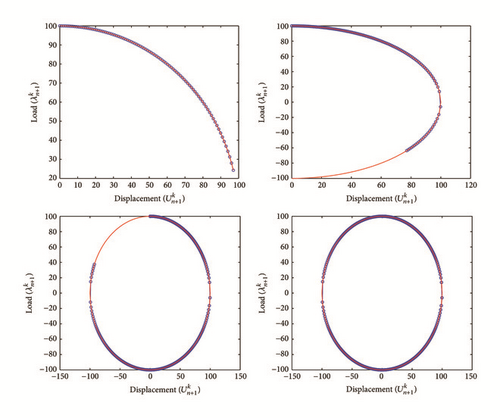

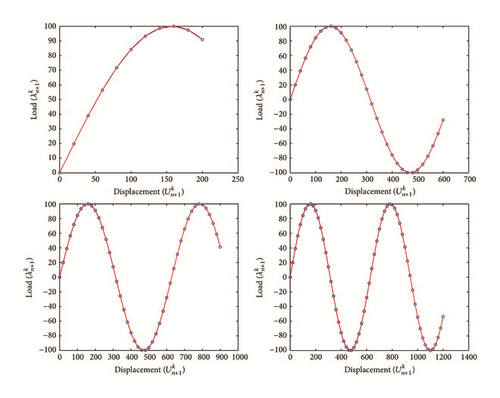
4.3.2. Sensibility Analysis
In this section, we propose a sensibility analysis for evaluating the influence of different values assigned with the parameters (α, β, and γ) used by the new iterative numerical continuation algorithm (see Section 3). All the numerical results associated with the scalar nonlinear functions (E1), (E2), and (E3) (see Section 4.2) with different values of the parameters (α, β, and γ) are presented in Figures 7–30.
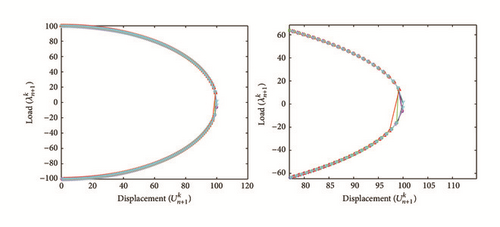
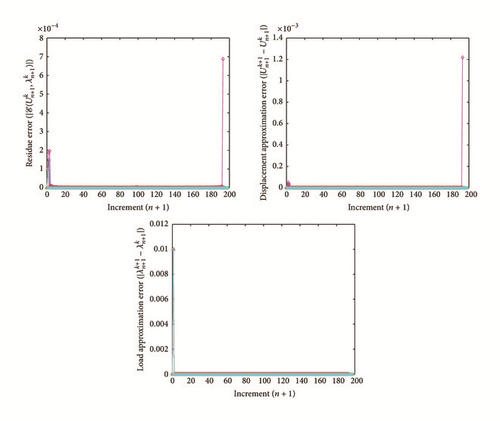
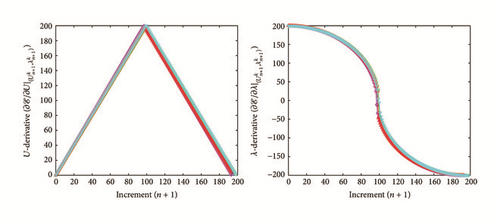
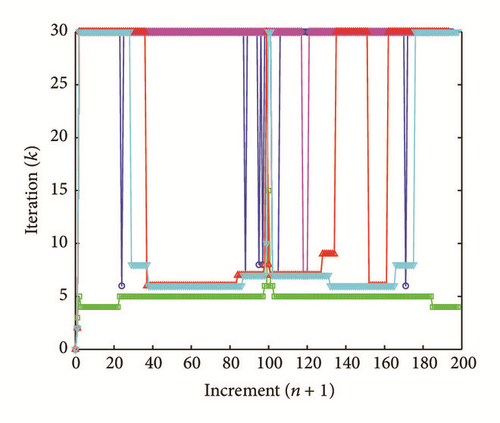
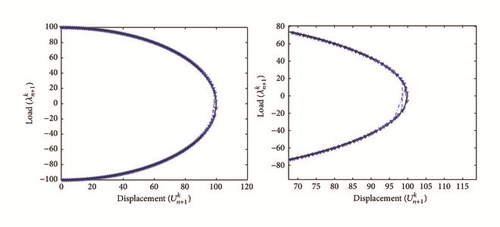

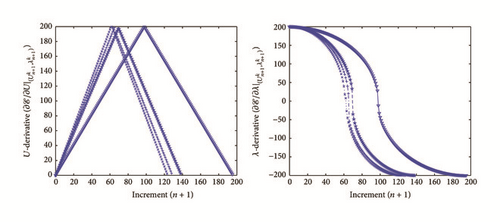
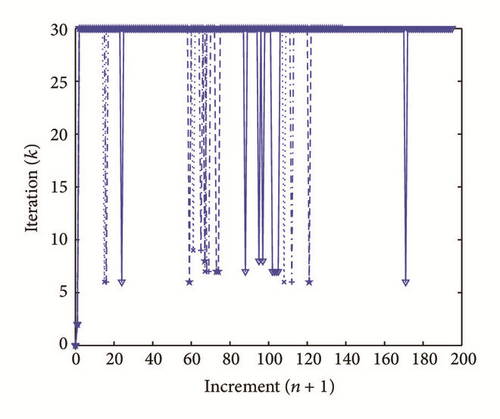

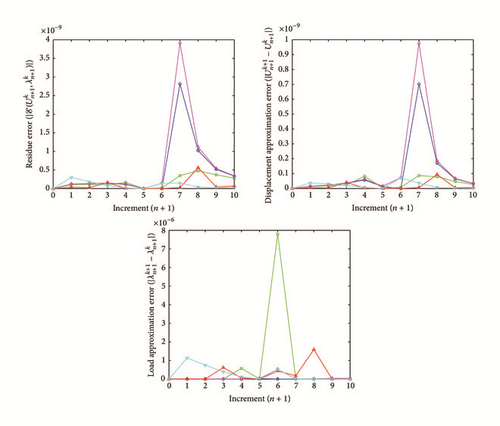
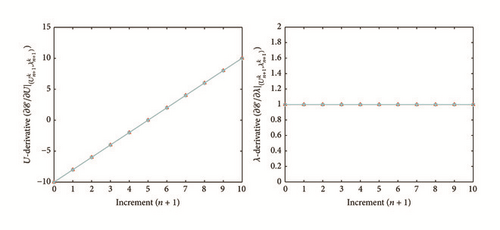
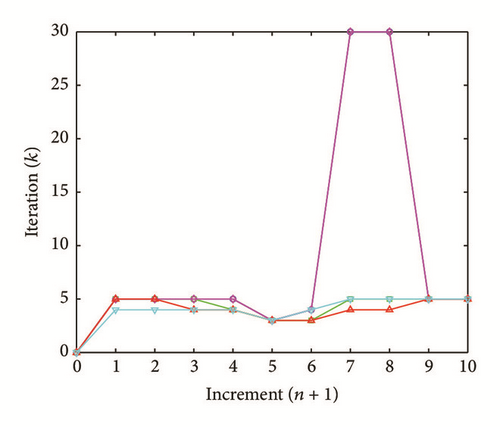
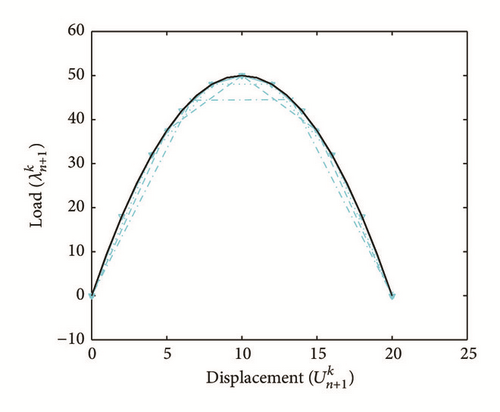
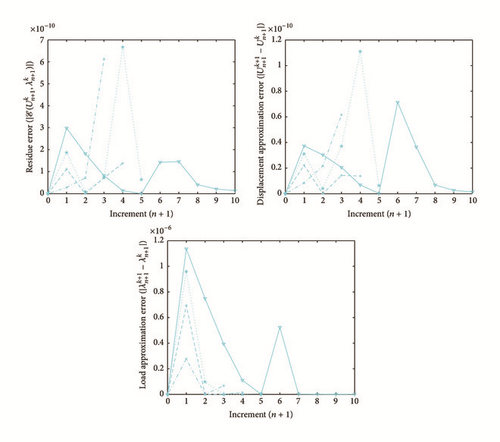
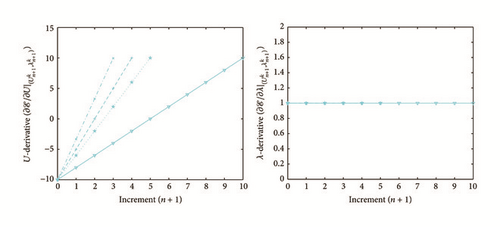
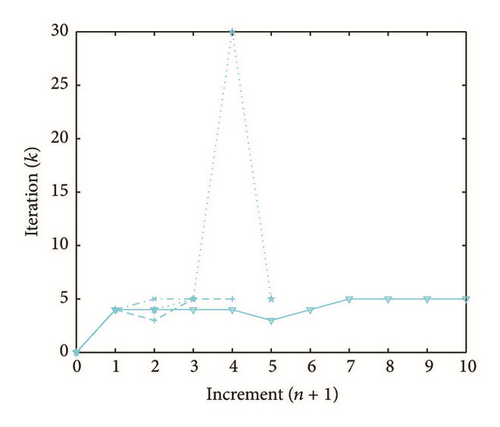
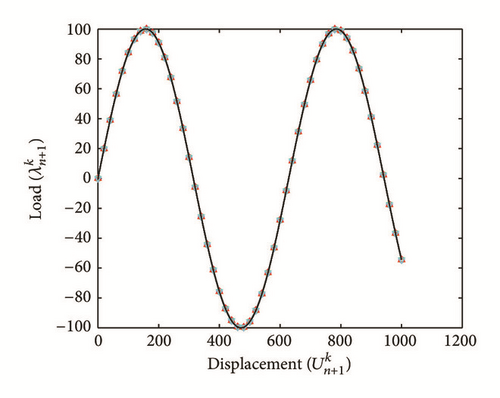

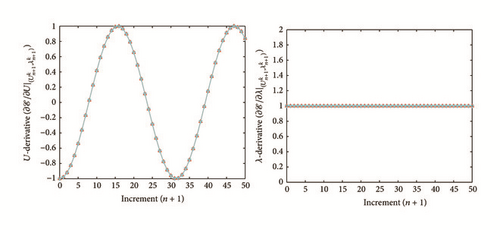

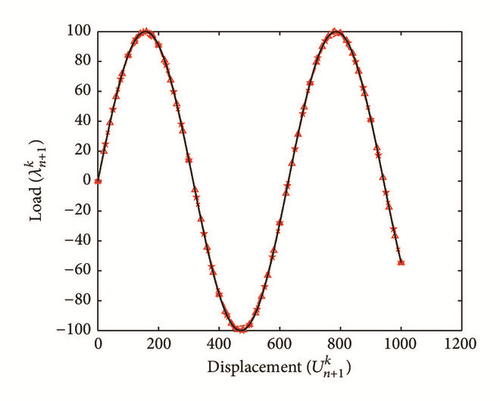
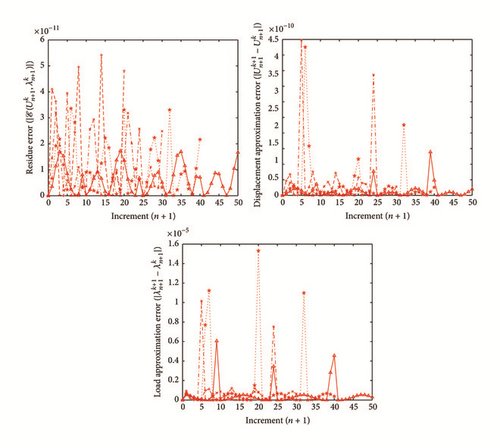

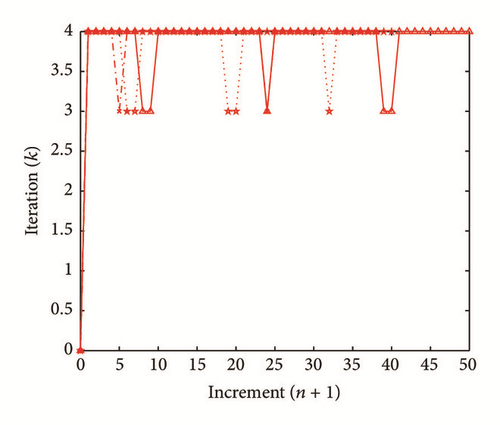
In the light of all numerical results obtained in Sections 4.3.1 and 4.3.2, the new iterative numerical continuation algorithm is a relatively accurate, efficient, and robust method that allows passing specific critical points and providing suitable approximate solutions associated with parameterized scalar nonlinear equations.
5. Conclusion
The present paper is devoted to a new iterative numerical continuation procedure for approximating the solutions associated with parameterized scalar nonlinear equations. Coupled with a modified Newton-type method and a stationary numerical technique, the presented algorithm is capable of providing satisfactory numerical solutions for scalar nonlinear equations using one control parameter. Through some illustrative examples, the predictive abilities of this new algorithm are tested, assessed, and discussed.
Competing Interests
The author declares that he has no competing interests.




